Growing plants in unusual containers
• Create a scenery with pots
• Growing plants in unusual containers
• Make your potted plants more beautiful
• Choose the material of pots
• Look after your pots to make them last
• The right pot for the right plant
• Upright-growing plants in pot
• Growing a tree in a pot
• Hiding a cumbersome stump
• Hiding the compost heap
• Optimize Trees
• How to redesign a flowerbed ?
• Create a flowering border like a painter
• Harmonise foliage between them
• Succeed with your borders
• An attractive garden in winter
• Create a Mediterranean corner
• Create an exotic area
• Create a Japanese corner
• Create a green roof
• Create a rockery
• An Acer, for all gardens
Transforming a container as a flower pot, it is a way of offering it a new life. But there are some rules to obey, for the plants’ well-being as well as the aesthetic!
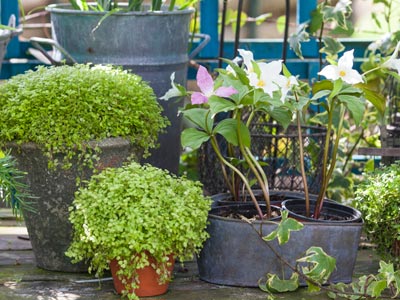
An assortment of salvaged containers.
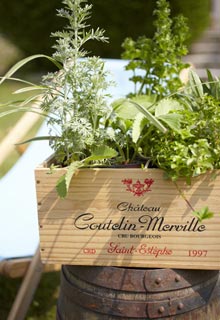
Wooden boxes
Whether they are made to house plants like the versaillaise boxes (The Rolls Royce for citrus plants) or recycled packaging, wood is suitable for plants. At least if it is protected with a good quality stain-paint or a paint which protects it from humidity. You can also line it with a plastic sheet (like the protective film used to grow strawberries), to be glued or stapled. Wood takes on a beautiful patina and last between 3 and 5 years on average, depending on the variety, the thickness, the type of plank, etc.
Which plants? Quick growing and long- lasting plants like the aromatic plants, ornamental grasses, Euphorbias, etc. are well suited to this type of container. Shrubs will also thrive in it but they will need a new container after a few years.
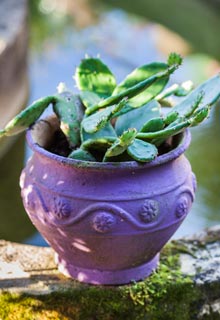
In ceramic
Besides varnished pots, it is possible to distort numerous ceramic objects to house plants in, like old soup tureen. The advantage of this material lies in its humidity-resistance. You must start by piercing it, using a tiles’ drill bit to place draining holes which are essential, unless you plan on growing plants which need wet soil permanently. You need one hole per litre of volume, so 3 holes for a big soup tureen. The earthenware brings in immediately a bric-a-brac look but it does not resist well to frost in winter. Remember to empty it on the approach of the cold, at the end of the season. That way, you will be able to keep it for years.
Which plants? All the plants which have an earth-ball small enough to go in the container and which are easy to remove at the end of the year: Ferns, ornamental grasses, flowering bulbs, thyme, strawberries, etc.
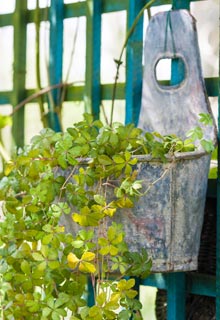
Metal containers
Whether it is an old laundry-washing bowls or a distorted object, metal offers a unique patina which harmonises well with plants. The metal takes on straight away an oxidised-look when in contact with plants: if this is not the aim you are looking for, it is best to opt for a traditional container, in resin for example. Otherwise, you can transform the object in a pot, ensuring that the bottom is pierced with at least 3 to 5 draining holes and allow a good layer of draining matter at the bottom. Place it on blocks to ease water drainage. Beware though, in summer metal heats up in the sun. A shady site or partially-shaded site is better suited to this type of container.
Which plants? Shrubs and climbers like the big volumes offered by metal containers such as laundry-washing bowls. You can also envisage a pot-grown vegetable patch.
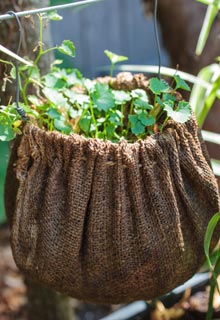
Bags and soft containers
Soft containers which are filled with soil and garnished with plants are well suited to a long-term use if they are manufactured with fibres which are bad weather -resistant, like vegetable plots in bags. In this case there is not a lot to do after planting. But if you wish to recycle a bag made of a different material, remember to place it protected from sun-rays and see it as a short-lived option, for one season only. After one year, the rain and the sun will probably have defeated its seams and its rivets. Old hand-bags, trousers and saddlebags which have become useless will find a new lease of live. Use light substrate.
Which plants? Trailing plants such as Ivy, ground-covering Geranium, and Heucheras... All of them are easy to transplant once the container has ended its life.















































































































































































































































